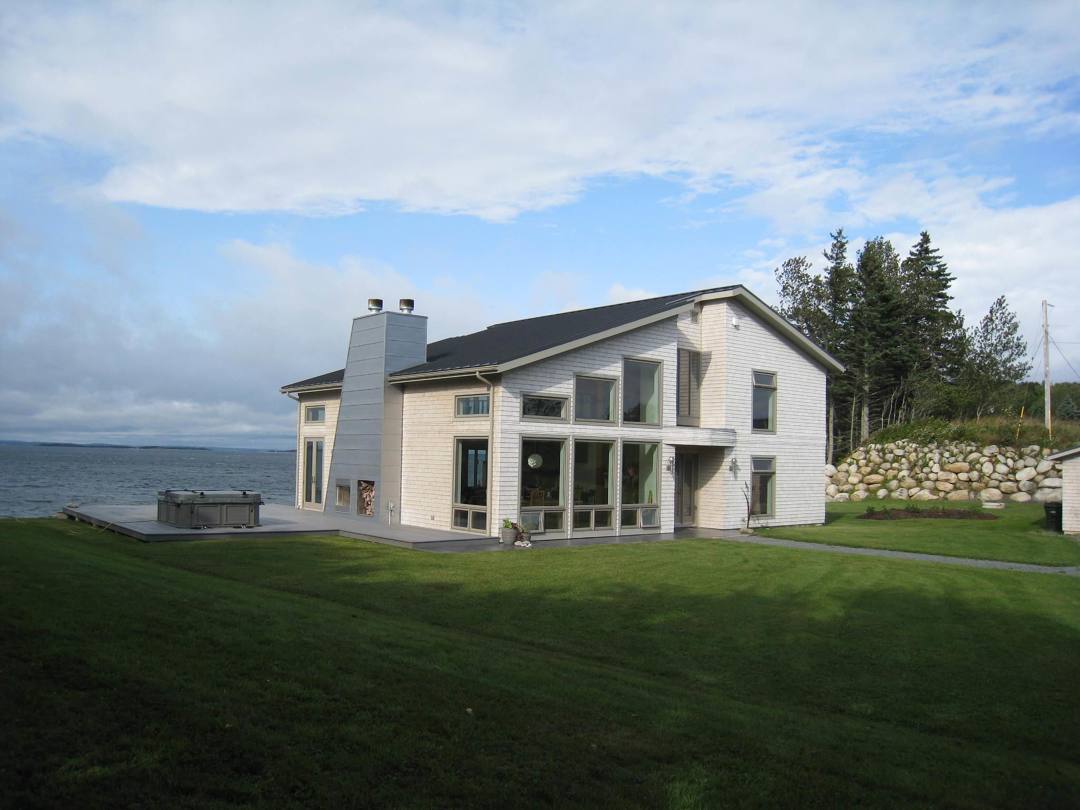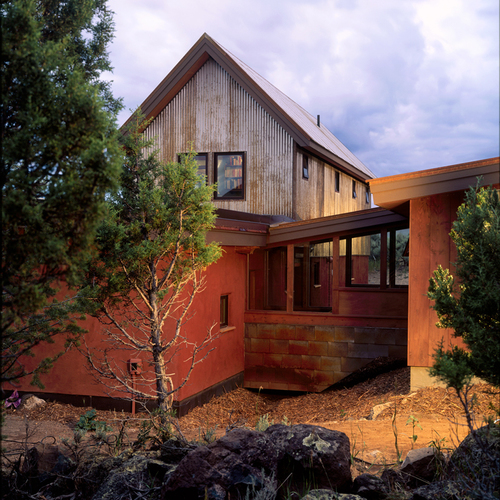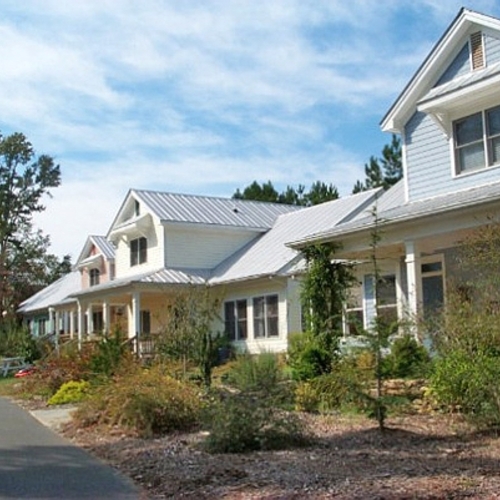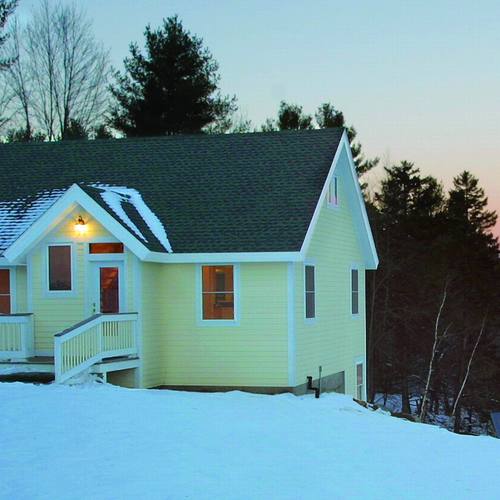
Image Credit: Jennifer Corson
Image Credit: Jennifer Corson Rustic stone steps lead right down to the seaside.
Image Credit: Jennifer Corson Unlike roof mounted collectors, the ground-mounted hot-water solar collectors don't put any extra burden on the building envelope. They are also more convenient to maintain.
Image Credit: Jennifer Corson Right on the “typical” line: 83,956 kBtu/year. But coastal Nova Scotia is hardly a typical location - when compared to local energy consumption, this is a respectable achievement. A number of strategies push this home toward energy independence. In warmer months, operable windows allow cooling ocean breezes to pass through the home’s open spaces. Expansive walls of glass let in light year round. An active solar thermal system provides domestic hot water and warms the radiant slab when heat is called for.
#A Study in the Efficient Use of Natural Resources
Perched on a coastal peninsula near Lunenburg, Nova Scotia, this contemporary home is used mostly as a summer residence, but with a design that includes active and passive solar heat, a high-thermal-mass radiant slab floor, and thorough air sealing and insulation, it’s a nice place to be in any season.
Year-round comfort
Owners John and Rosemary wanted to create an environmentally responsible home that could some day run completely off the grid. The six solar hot-water collectors push the house toward energy independence, but the extreme North Atlantic conditions warranted adding a supplemental gas-fired boiler for winter heat. A heat-recovery ventilator brings fresh air into this super-tight home without bringing in the cold.
Many of the energy-efficient design elements really shine in the warmer months, which is when the house gets the most use. An open floor plan with 19-foot ceilings and operable windows at different heights allow the cool ocean breeze and plenty of sunlight to pass through the house. Ceiling fans help the house stay cool when the winds are calmer.
Natural resources used wisely
The metal roofing does more than keep the weather out. It directs rain into a 4,000-gallon cistern, for both domestic water and irrigation. So far, the cistern has been the sole water provider, although the home does have a backup well. FSC-certified birch stairs, interior paneling of renewable strawboard, and the engineered lumber used for all structural spans add up to a home that was frugal with resources from the start.
New inspires old
This was the first time John and Rosemary built a home, and it was also their first experience with sustainable design. It went so well that they recently incorporated similar principles into the renovation of their 1850s home in England.
Weekly Newsletter
Get building science and energy efficiency advice, plus special offers, in your inbox.
Lessons Learned
In a perfect world we would use the best techniques and choose the best site and every building would perform to its optimal level. Unfortunately, needs, wants, and available resources don't usually make best-case scenarios practical. Magnificent ocean views mean an exposed site with no natural shelter from the North Atlantic winds.
Taking advantage of these views demanded plenty of windows on the north side, which further complicated the construction of a well-insulated home. Solterre Design applied its passion for and expertise in energy efficiency to a challenging situation and, to the delight of John and Rosemary, created a durable, comfortable, energy conserving home.
General Specs and Team
| Location: | Second Peninsula (near Lunenburg), NS |
|---|---|
| Bedrooms: | 4 |
| Bathrooms: | 2.5 |
| Living Space: | 2780 |
Builder: Norman Whynot, Kinburn Properties
Architect/Designer: Solterre Design
Engineer: Weyerhauser (truss system), Nu Air Ventilation (enerboss and HRV design)
Construction
Foundation: slab on grade over 2 in. XPS insulation (R-10); hydronic in-floor heat, ceramic tile, and engineered hardwood flooring
Walls: 2x6; fiberglass insulation and 1-1/2-in. rigid XPS insulation sheathing (R-26); 5/8-in. gypsum board for additional thermal mass
Roof: vented, TJI rafters with fiberglass batt insulation and metal roofing (R-40, Trus Joist)
Windows: double-glazed, low-e, argon-filled; SHGC = 0.41, U = 0.32, R-3.13 (Marvin)
Garage: detached
Energy
- Passive solar heat
- Slab providing thermal mass
- Solar domestic hot water and hydronic radiant heat
- Window layout provides abundant daylighting
Energy Specs
Heating/cooling: in-floor radiant heat in main floor slab-on-grade; hydronic radiators on the second floor; glycol-filled solar collectors with 100-gallon storage tank; gas-fired on-demand boiler (17,000-140,000 btu, Takagi); passive cooling
Water heating: same as space heat
Annual energy use: 84 MMBtu
Water Efficiency
- Rainwater collection from metal roof to 4,000-gal. cistern with backup dug well
- Low-flow toilets
- Low-flow faucets
Indoor Air Quality
- Low-VOC paints
- Prefinished hardwood flooring
- Whole-house ventilation with HRV
- Detached garage
- Formaldehyde-free composite wood products
Green Materials and Resource Efficiency
- Renewable strawboard used as interior wall surface
- Local hardwood flooring on upper level
- Engineered wood for all spanning members
- FSC solid birch treads on open stair system











One Comment
NS Getaway...
Another superb example of design, thought, engineering, construction, and, well, everything. Kudos to this project and all it's people too!
Log in or create an account to post a comment.
Sign up Log in